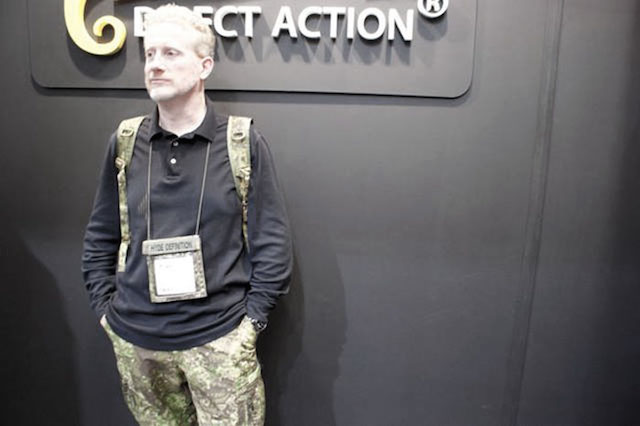Get the weekly SPARTANAT newsletter.
Your bonus: the free E-Book from SPARTANAT.

PenCott is more natural and organic.
These are not just pixels, this is more. PenCott is the name of a series of new camouflage patterns that are currently making a strong push in the market and are being seen more and more with gear. We wanted to know from the people behind it what is new about PenCott and interviewed Lawrence Holsworth, who does the marketing for PenCott.
SPARTANAT: A new camouflage? Why? What makes PenCott better?
Lawrence Holsworth: The PenCott family of camouflage patterns has a unique, hybrid, fragmented geometry that is more organic and natural than typical digital patterns, and therefore camouflages better at short, medium, and long distances.
SPARTANAT: Where does the name come from actually?
Lawrence Holsworth: PenCott was named after two British pioneers of camouflage technology from World War II. Sir Roland Penrose and Hugh B. Cott: Penrose was an artist who used his training and intuition to design camouflage patterns with contrasting colors, tones, and fragmented shapes. Cott was a biologist who believed that art was not relevant in a scientifically analytical process. He looked to natural camouflage patterns to find effective designs.
SPARTANAT: So is PenCott a kind of digital pattern like AOR or MARPAT?
Lawrence Holsworth: It is a digital pattern - but not in the typical "pixelated" form. PenCott is a hybrid, a micro-pattern with blurred pixel shapes combined with a mid-pattern of inconsistent medium-sized elements and a macro-pattern of larger inconsistent elements. The result is a very complex fragmented pattern that confuses the observer's eyes, blends into the textures of the natural environment, and breaks up the form of the wearer with exceptional efficiency.
SPARTANAT: Who is behind PenCott?
Lawrence Holsworth: Dominic Hyde, CEO and chief designer, is an internationally recognized specialist in camouflage pattern design and a member of the International Camouflage Uniform Society. Dominic's long-standing interest in the art of camouflage - experimenting with techniques and patterns since childhood - led to the creation of more than 2,000 camouflage patterns for clothing, vehicles, and infrastructure. Even during his military service in a Territorial Regiment of the Royal Artillery of the British Army, Dominic was able to apply his passion for camouflage and concealment in practice.
SPARTANAT: How was PenCott developed?
Lawrence Holsworth: Around 2005, Dominic Hyde began work on the PenCott pattern, independently of any government contracts and several years before many countries started to change their camouflage patterns. Dominic took a fresh, pragmatic, and comprehensive approach to design a pattern that effectively:
- works across multiple types of terrain and environments,
- in areas with little natural cover,
- across short, medium, and long distances,
- and appears more natural than pixelated patterns.
In addition to analyzing camouflage patterns worldwide, over time Dominic also studied modern combat operations and ground missions to understand the specific weaknesses of current patterns.
Dominic also examined camouflage patterns found in nature, particularly those of animals whose survival or hunting strategy depends more on camouflage than strength or speed. For humans, he added the theory of form - an approach from psychology - and incorporated physiological insights into how the human eye functions. Ultimately, Dominic had more than a dozen prototype patterns and over 200 color combinations that he designed, tested, and analyzed. Through a field trial with clothing made from appropriately printed fabrics, the final patterns and color combinations were determined.
SPARTANAT: What does the PenCott family look like today?
Lawrence Holsworth: The PenCott Multi-Terrain Pattern family currently consists of the following variants:
- GreenZone - for tropical, semi-tropical, and green terrain in temperate zones
- BadLands - for dry, semi-arid, transitional terrain, as well as high and bushland
- SandStorm - for dry, steppe-like terrain and desert
- SnowDrift - for snow-covered terrain
- Metropolis - for urban terrain or industrial areas (available from the second half of 2013)
PenCott is the only commercially available British-designed camouflage pattern family that has proven its effectiveness worldwide.
SPARTANAT: How is PenCott received by manufacturers? Who offers such equipment?
Lawrence Holsworth: Fortunately, we have the opportunity to work with some of the best clothing and equipment manufacturers in the world. At the same time, we regularly expand our network of partners, so it is best to visit our website and Facebook page for the latest updates and developments. What is very gratifying for us is that some of the best special forces in the Free World rely on the camouflage advantages of our patterns to carry out their missions more efficiently.
LAWRENCE HOLSWORTH (right, with Dom Hyde, left, and Mr. SnowDrift, center), Business Development and Marketing Director, is a well-known equipment and camouflage expert. He is the founder and chief editor of the Strike-Hold! Blogs and a former non-commissioned officer with the 82nd Airborne Division. He has more than 20 years of experience in international marketing and communication.
PenCott on the Web: http://www.hydedefinition.com/
PenCott on Facebook: https://www.facebook.com/Pencottcamouflage
PenCott Reviews on SPARTANAT:
GreenZone: UF PRO P-40 Camou
BadLands: SABRE Special Forces Pant Gen II
SPARTANAT is the online magazine for Military News, Tactical Life, Gear & Reviews.
Send us your news: [email protected]
Ad
similar
Get the weekly SPARTANAT newsletter.
Your bonus: the free E-Book from SPARTANAT.


